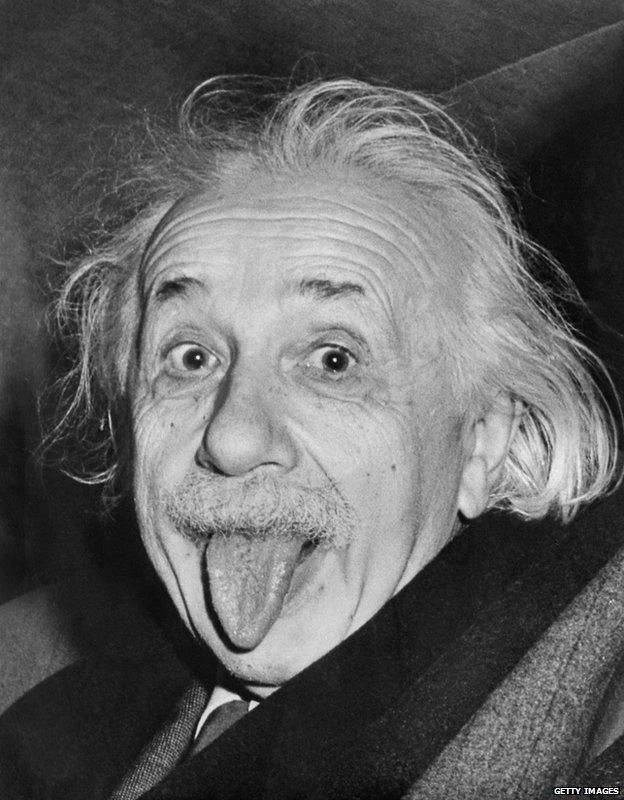The strange afterlife of Einstein's brain
- Published
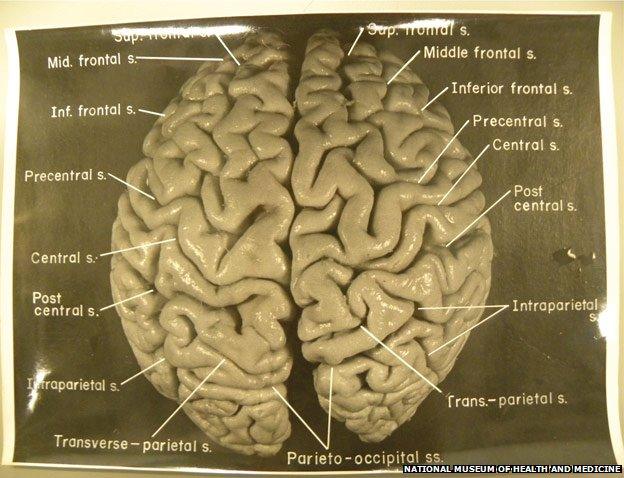
Einstein's death 60 years ago was just the start of a strange journey for the most prized part of his anatomy, his brain. Stored in jars and on slides, it is still inspiring awe and scholarly research.
At 01:15 in the morning of 18 April 1955, Albert Einstein - theoretical physicist, peace campaigner and undisputed genius - mumbled a few words in German, took two breaths, and died. The nurse on duty at Princeton Hospital did not speak German and the meaning of Einstein's final words was lost forever.
Einstein's cremation took place later that day in Trenton, New Jersey, but the following day his son, Hans Albert, learned that the body in the coffin had not been intact. A front-page article in the New York Times reported that "the brain that worked out the theory of relativity and made possible the development of nuclear fission" had been removed "for scientific study".
The pathologist who conducted the autopsy, Dr Thomas Harvey, had gone further than simply identifying the cause of death - a burst aorta. He had sawed open Einstein's cranium and removed its celebrated contents.
"He had some big professional hopes pinned on that brain," says Carolyn Abraham, who met Harvey while researching her book Possessing Genius: The Bizarre Odyssey of Einstein's Brain. "I think he had hoped to make a name for himself in medicine in a way that he had been unable to do. And then he comes to work one morning and finds Albert Einstein on his autopsy table."
Hans Albert was furious. His father had been a modest man who had been cremated without ceremony, and had asked for his ashes be scattered in secret to prevent the site becoming a place of pilgrimage.
But Einstein had also, at some point, given people to believe he was happy for scientists to use his body for research. Harvey convinced Hans Albert to grant permission for a study of Einstein's brain in the hope it would, as the New York Times put it later, "shed light on one of nature's greatest mysteries - the secret of genius".
Harvey, controversially, took possession of the brain. "Whether he took it for himself, or took it for science - it was hard for people to know which, and that's what put him in the crosshairs for a lot of people," says the journalist Michael Paterniti, who met Harvey near the end of his life. Harvey was not a neurologist, but he promised to marshal the country's greatest specialists to study the brain, and to publish their findings soon.
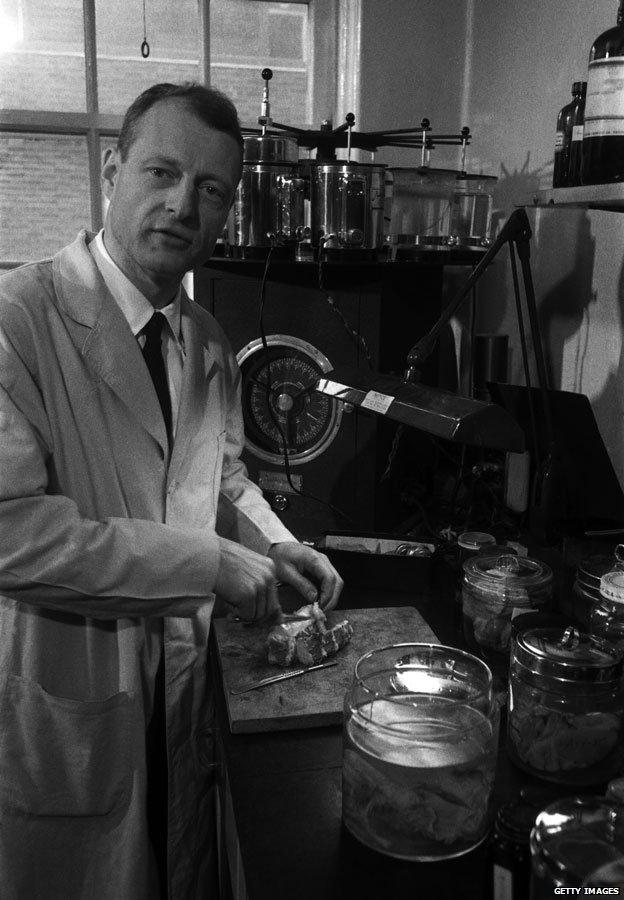
Years passed, however, and no scientific paper emerged. After a while, Einstein's brain was forgotten.
Then, in 1978 a young reporter, Steven Levy, was dispatched by his editor to find the illustrious organ. The brain was nowhere to be seen at Princeton Medical Center, as Princeton Hospital was then called, and neither was Thomas Harvey. Levy eventually tracked him down to Wichita, Kansas.
"I told him, 'I'm writing a story about Einstein's brain.' The first thing he said was: 'I really can't help you with that,'" Levy remembers. "He wasn't eager to talk."
In the end, though, Harvey agreed to meet the reporter in his office in the small medical lab where he was working and it quickly became apparent, to Levy's surprise, that Harvey still aspired to publish a scientific report.
"He was a somewhat introverted guy, a polite guy," Levy recalls. "But as the conversation went on, he had a pride that he was doing this study, but he didn't really have good answers as to why, after almost 25 years, nothing had been published."
When Levy pressed Harvey to see some pictures of the brain, a strange look came over the doctor's face. Grinning sheepishly, he stood up, walked behind Levy to the corner of the room, and removed a beer cooler from a stack of cardboard boxes. The bottom box was labelled Costa Cider.
"He reaches in, pulls out these big mason jars," says Levy. "And there was Einstein's brain. It was amazing."
In Levy's article, published in the New Jersey Monthly, he described the contents of one of the jars. "A conch shell-shaped mass of wrinkly material the colour of clay after firing. A fist-sized chunk of greyish, lined substance, the apparent consistency of sponge. And in a separate pouch, a mass of pinkish-white strings resembling bloated dental floss."
A second, larger jar contained "dozens of rectangular translucent blocks, the size of Goldenberg's Peanut Chews".
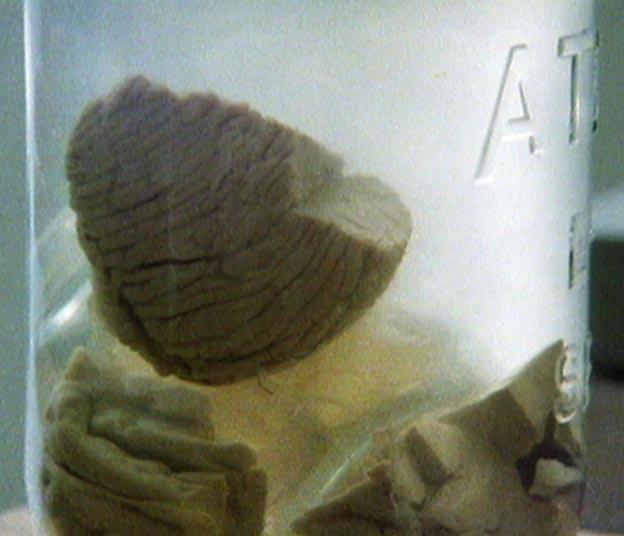
The brain in a jar reminded Steven Levy of confectionery
The missing 23 years have now been filled in.
Back in 1955, armed with Hans Albert Einstein's permission to conduct an investigation, Harvey had measured and photographed the brain and even commissioned a painting of it from an artist who had done portraits of his children.
In those early days, he was not acting alone, but had the support of Einstein's executor, Otto Nathan, and the physicist's friend, the neuropathologist Harry Zimmerman.
Harvey had overseen the division of the brain into 240 blocks, and created 12 sets of 200 slides containing tissue samples indexed to the blocks. These were delivered, as promised, to the great and the good of 1950s neuropathology.
But Harvey heard very little back from these august men. Those who did reply found it to be no different from normal, non-genius brains. This mirrored the result Harvey had received when he first weighed the brain, and found it to be - at 1,230g - towards the low end of the normal range for men of Einstein's age.
All the time, as he energetically ferried small samples of Einstein's brain across the US, he doggedly hung on to the bulk of it.
Among those who tried to take it from him was the US Army. "They felt that having it would put them on a par with the Russians, who were collecting their own brains at that time," says Abraham. "People were collecting brains - it was a thing."
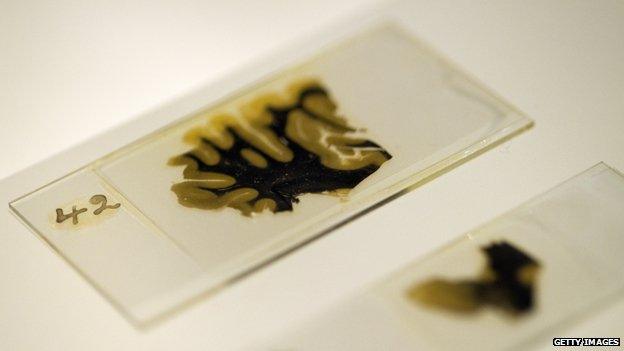
Slides of Einstein's brain on display at London's Wellcome Collection, 2012
But taking possession the brain set in motion a painful chain of events for Harvey.
"This was supposed to have been his great good luck charm but in fact it was much more like a relic cursed," says Abraham. "He lost everything after he took that brain. He lost his job, he lost his marriage, he lost his career at Princeton. After the controversy over having taking the brain, he never regained his footing at the hospital."
That explains why Harvey was in Wichita when Steven Levy caught up with him.
When the article appeared in summer 1978, Harvey was suddenly the centre of much attention. The journal Science interviewed him and reporters camped out on his lawn. He was approached for samples, by, among others, the neuro-anatomist Marian Diamond at the University of California, Berkeley. With the package that Harvey sent to Diamond by post, of four sugar cube-sized pieces of brain in a jar previously used for Kraft Miracle Whip mayonnaise, the era of Einstein brain studies finally took off.
What have these studies told us about Einstein's brain and the nature of intelligence?
Diamond's 1985 paper in Experimental Neurology identified one of the four brain samples as having more so-called glial cells for every neuron, compared to a control group of brains. Glial cells - which get their name from the Greek for "glue" - fix neurons into place and keep them supplied with oxygen and nutrients. In previous research on rats, Diamond had shown that a stimulating environment can lead to an increase in glial cell count. Perhaps the low ratio of neurons to glial cells in Einstein's brain sample reflected a life devoted to the biggest and most stimulating scientific puzzles?
More studies followed.
In 1996, Britt Anderson at the University of Alabama at Birmingham published a study on Einstein's prefrontal cortex. He found that the number of neurons was equivalent to brains in a control group, but they were more tightly packed, allowing, perhaps, for faster processing of information.
In a 1999 Lancet paper, Sandra Witelson from McMaster University in Canada studied Harvey's original photographs of Einstein's brain. She said that Einstein's inferior parietal lobule - the part of the brain responsible for spatial cognition and mathematical thought - was wider than normal, and seemed better integrated. Perhaps, Witelson speculated, the shape of the brain may relate to Einstein's own descriptions of his thinking in which "words do not seem to play any role", but there is an "associative play" of "more or less clear images"?
In 2012, the eminent anthropologist Dean Falk worked with a set of previously unseen photographs of Einstein's brain that Harvey had taken with an Exacta camera. She did a complete audit of the brain, naming every convolution and crevice, and found a number of unusual features.
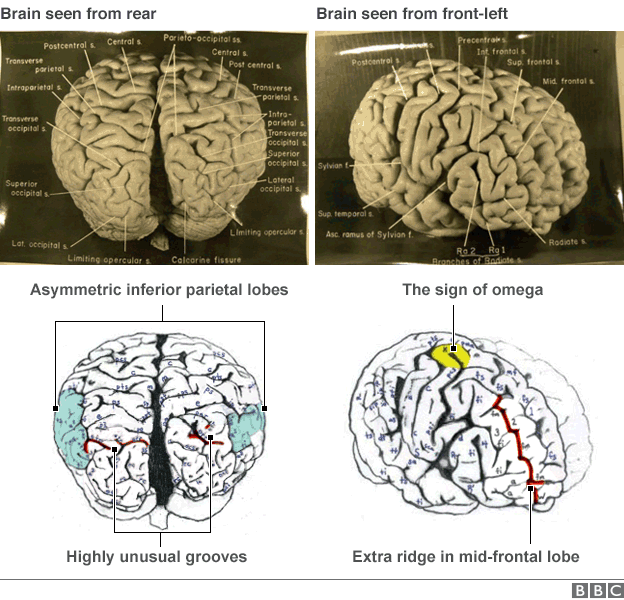
Based on Falk, Lepore & Noe, 2013, The cerebral cortex of Albert Einstein: a description and preliminary analysis of unpublished photographs, Brain 136(4):1304-27. Photographs of the brain reproduced with permission from the National Museum of Health and Medicine, Silver Spring, MD
Perhaps the most striking is that Einstein had an extra ridge on his mid-frontal lobe, the part used for making plans and working memory. Most people have three ridges but Einstein had four. She also found Einstein's parietal lobes were dramatically asymmetric, and he had a knob on his right motor strip. This latter feature is called the "sign of omega" and it is thought to be correlated to musicians who use their left hands. Einstein played the violin.
Falk was also named on a 2013 study that looked at Einstein's unusual corpus callosum, the bundle of fibres connecting the left and right hemispheres of the brain. The researchers found Einstein's was thicker than in control groups, suggesting enhanced co-operation between brain hemispheres.
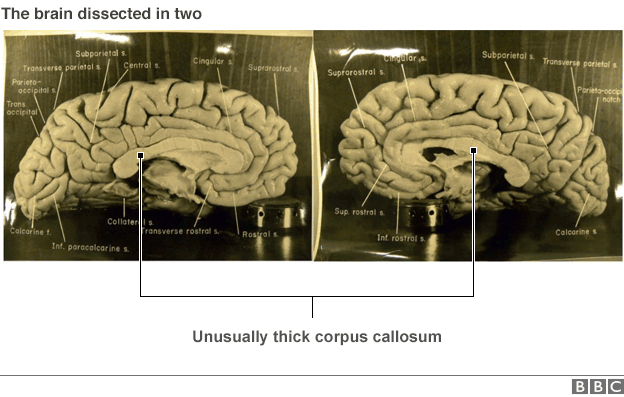
Based on Falk, Lepore & Noe, 2013, The cerebral cortex of Albert Einstein: a description and preliminary analysis of unpublished photographs, Brain 136(4):1304-27. Photographs of the brain reproduced with permission from the National Museum of Health and Medicine, Silver Spring, MD
The question arises: Are these features that Einstein developed throughout a life devoted to higher thought, or was he born with them? People are born with the basic pattern of convolutions in their brains, but the extent to which these are reshaped by experience is unknown. The sign of omega may have developed as Einstein practised the violin as a boy, Falk says, but she thinks it is more difficult to assess the contribution of life's experiences to other parts of the brain.
With each of these papers, starting with Marian Diamond in 1985, the press splashed the story with headlines suggesting that scientists had discovered the special neural wiring responsible for E=mc². The truth is that the links with Einstein's genius have never been anything more than speculative.
"You can't take just one brain of someone who is different from everyone else - and we pretty much all are - and say, 'Ah-ha! I have found the thing that makes T Hines a stamp collector!" says Terence Hines, a psychologist and stamp collector at Pace University who has been very critical of all the Einstein brain studies. "If you have this notion that stamp collecting was caused by something different in the brain, and you looked at my brain and compared my brain to 100 other brains, you could find something different and say 'Ah-ha! I have found the centre of stamp-collecting.' And it's bull."
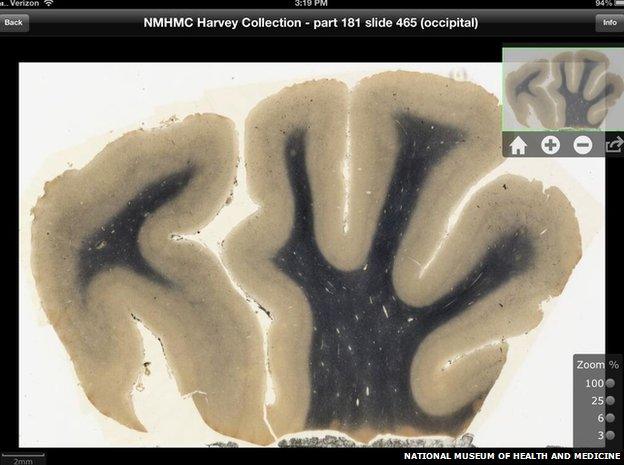
An app showing Harvey's slides of Einstein's brain is available for iPad
Hines has accused the scientists involved in the Einstein brain studies of being caught up in what he calls the "neuromythology" of Einstein's brain.
The first victim of this tendency was arguably Harvey himself. He told Steven Levy in 1978 that all the research so far conducted on the brain "showed it to be within normal limits for a man his age". But rather than publishing these results, Harvey waited for exceptional differences to turn up, differences worthy of an exceptional man.
This "selection bias" was also evident in the first of the studies to find a possibly significant difference - Marian Diamond's. She subjected the four brain samples to seven different tests, Hines says, but Einstein's brain only came back as unusual in one of the measures - the glial cells - and only in one of the samples.
In what has become a bitter spat about the body of a famously mild-mannered man, Falk and her co-writers insist that Einstein's brain is exceptional. There is a natural variation in our brain anatomy, true, but Einstein possessed unusual features in every cerebral lobe, some very unusual.
But they are willing to accept that it's impossible to map these anatomical differences on to Einstein's genius with any certainty. "I don't know if Einstein was a genius because his parietal lobes were different," says say Dr Frederick Lepore, a neurologist who worked with Dean Falk on the 2012 paper. "If you put my feet to the fire and you say, 'Where's special relativity? Where did general relativity come from?' - we have no idea."
Einstein was, of course, lots of things besides being a genius. He was bilingual, musical and even - it has been suggested - autistic.

Hines makes the point that to correlate an unusual feature of the brain to a characteristic you need lots of brains with those unusual features. The easiest way to do it, he says, would be to put a lot of geniuses through the flashiest neural imaging scanner you can afford - perhaps by taking the scanner to the Large Hadron Collider and get the scientists there to form a queue. "They may not find anything, but that would be far more productive than slicing and dicing one or two brains of geniuses," he says.
Recent published research on Einstein's brain has used Harvey's photographs, as it's no longer easy to get access to brain samples themselves. In 1998, Thomas Harvey handed the 170 chunks of brain still in his possession to Dr Elliot Kraus, chief pathologist at the University Medical Center of Princeton at Plainsboro, the current name for the institution where Einstein himself was sliced and diced in April 1955.
"If you say, where's the brain? It's about five miles from my office in Plainsboro, New Jersey, and you can't get access to it," says Frederick Lepore. "At least Tom Harvey would send pieces out. Krauss is not allowing access to this brain."
Elliot Krauss denies this. He says he sent some samples for DNA analysis, and although they were too damaged to be useful, in the future the technology may be sophisticated enough to examine them by this method. "I think I am waiting till someone comes with a really good proposal on the material, but I would have to be comfortable that they're not looking at it just to have some, and the notoriety of possessing some," says Krauss. "There has to be a real good scientific reason for having it."
Keeping the brain, Krauss says, is an honour and a burden - one that Thomas Harvey shouldered for more than 40 years. Krauss has said in the past that Harvey did "a great service", but no-one would say he didn't sometimes make bad mistakes. In a 1994 BBC documentary, the octogenarian is seen wandering into his kitchen with one of his mason jars and slicing off a piece of Einstein's brain on a cheeseboard for a visitor to take home as a memento.
"Relics: Einstein's Brain", directed by Kevin Hull, appeared in the BBC's Arena strand in 1994
It's an interesting moment. The visitor, Kenji Sugimoto, has been on a pilgrimage to find the brain of his idol and the possibility that he might be about to receive an actual relic of this nuclear-age saint is almost too much for him. But one senses that Harvey gives Sugimoto a piece of Einstein not out of charitable fellow-feeling, but a profound lack of sentimentality about his prized possession.
Shortly after this sequence, the Yale-educated doctor is shown working in a plastics factory to pay the bills. Notwithstanding money troubles, Harvey never sold any of his troublesome cargo.
"Really I do think that his were sins of omission rather than commission," says Carolyn Abraham. "If he was really serious about wanting the brain to be studied I think at some point he should have turned it over to people who could have properly studied it."
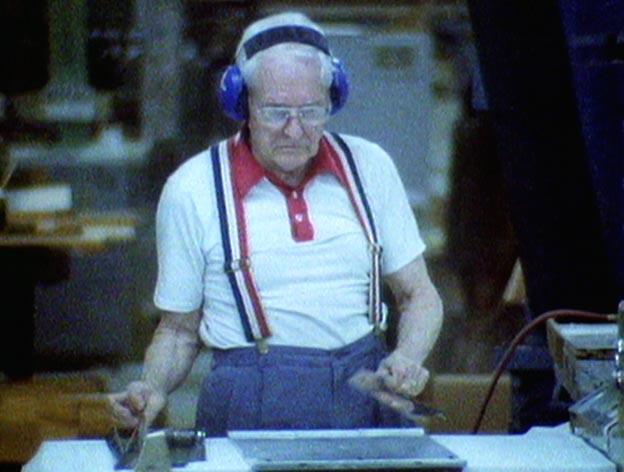
Harvey working in a factory in 1994, in the BBC documentary film
She believes there are probably slivers of Einstein in attics across America - the samples distributed by Harvey to scientists who then kept them as interesting curios.
In 1997, Michael Paterniti went on a road trip with Harvey across the US with Einstein's brain in a plastic container in the boot, an experience he described in his book Driving Mr Albert. He describes Harvey as "a very nice, quiet person" who evaded difficult questions about his actions. "Sometimes his response was just to fall into a deep silence. And sometimes these silences could last the length of an entire state."
Although the brain's scientific significance remains debatable, its story has been culturally productive, spawning a novel, a comic book and even a play by Nick Payne, inspired by Harvey's story, which will open in New York next month.
Whether one sees all this as a sad addendum to Einstein's truly world-changing life or a touching sign of how deeply revered he was by the normal-brained majority is a matter of opinion. But according to Carolyn Abrahams on thing is certain: "As long as Einstein's tongue adorns t-shirts, we'll be talking about his brain."
Michael Paterniti and Dr Frederick Lepore spoke to Health Check on the BBC World Service. Listen to the programme on iPlayer or get the Health Check podcast. Subscribe to the BBC News Magazine's email newsletter to get articles sent to your inbox.
